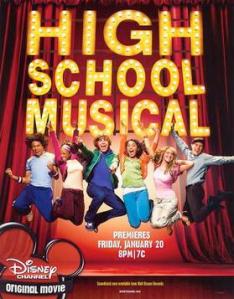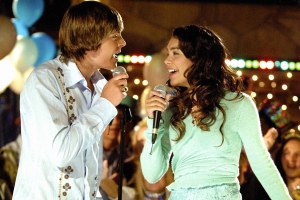 In this season of festive frivolity (and guilty pleasures), what could be more frivolous than the Disney Channel TV movie “High School Musical”?
In this season of festive frivolity (and guilty pleasures), what could be more frivolous than the Disney Channel TV movie “High School Musical”?
Yet there may be a few interesting words to say about it.
The Phenomenon
If by some chance you’re not familiar with HSM, the Wikipedia article has a detailed description of the production, plot, and characters. You can brush up there; I’ll wait.
Since the early 1980s, the Disney Channel has produced a formidable list of original made-for-TV movies, generally aimed at a tween-to-teen audience. Few of them make much impact on the general moviegoing public, though a number of actors and musicians have gotten their start in the “DCOM” venue. But every now and then one finds something more substantial among the fluff.
Such surprise successes are not unknown among more adult movies. No one expected Casablanca to become a film classic when it came out in 1942. It’s A Wonderful Life, with disappointing results in its original 1946 release, became a beloved holiday heartwarmer in the 1970s.
Disney didn’t expect anything extraordinary from HSM, either. But the movie was a whirlwind success in its target age group. Disney, always ready to strike when the iron turns out to be hot, followed up the original HSM not only with the conventional TV sequel but also with a third episode that was released in theatres—“the first and only DCOM to have a theatrical sequel,” according to Wikipedia.
When HSM premiered in 2006, I had a daughter at the right age to be interested; that’s how I came to see the show. But I was favorably impressed. As lighthearted romantic fluff goes, this venture was pretty enjoyable.
Clearly, the HSM team did something right.
The Chemistry
 A romantic comedy can’t work unless the couple appeals to us. In this respect, HSM hits the right note from the initial meet-cute. Teenage strangers Troy Bolton (basketball star) and Gabriella Montez (science-oriented A student) are propelled onstage at random by a boisterous karaoke crowd at a resort’s New Year’s Eve party. By the usual musical-theatre convention, they sing the required duet perfectly, without any prompting, though they act as if they’re amateurs trying this for the first time. We watch them gradually loosen up, exchange shy glances, and get into the song with enthusiasm. It’s entirely adorable. The song itself, with the refrain “This could be the start of something new,” fits neatly with the beginning of a relationship.
A romantic comedy can’t work unless the couple appeals to us. In this respect, HSM hits the right note from the initial meet-cute. Teenage strangers Troy Bolton (basketball star) and Gabriella Montez (science-oriented A student) are propelled onstage at random by a boisterous karaoke crowd at a resort’s New Year’s Eve party. By the usual musical-theatre convention, they sing the required duet perfectly, without any prompting, though they act as if they’re amateurs trying this for the first time. We watch them gradually loosen up, exchange shy glances, and get into the song with enthusiasm. It’s entirely adorable. The song itself, with the refrain “This could be the start of something new,” fits neatly with the beginning of a relationship.
Romantic chemistry is to some extent in the eye of the beholder. But I felt the actors and filmmakers did a good job of making the romantic interest both credible and enjoyable. (To mention only one example of a film that fails in this respect: Star Wars fans will wince in unison when reminded of the fact that the prequel trilogy requires us to treat Anakin and Padmé as heroes of an epic romance, but the actors have no chemistry whatsoever.)
The Tropes
HSM is a gallery of familiar tropes—but it does some interesting things with them.
The idea of star-crossed lovers whose groups are at odds goes back to Romeo and Juliet—or Pyramus and Thisbe. Using the traditional high-school dichotomy of jocks and nerds to create this opposition makes the situation ripe for comedy. But what makes HSM interesting is that there’s a third force involved: the drama club.
While the sports championship and the scholastic decathlon preoccupy the basketball team and the brainy types, Troy and Gabriella are really trying to succeed at a third thing—trying out for the spring musical. Their real opposition is the reigning drama queen, Sharpay, with her acquiescent brother and dance partner Ryan. Having three factions in play complicates the standard “Two houses, both alike in dignity” plotline. It also allows for a satisfying alliance of the sports and science factions at the climax, when they conspire to create simultaneous disruptions so that Troy and Gabriella can appear at the all-important (I’m trying to say that with a straight face) callback auditions.
 Similarly, the basic theme of the show is a classic (especially for teenagers) “do your own thing” or “be yourself” message. But the three-party problem points this up in a slightly unexpected way. Troy and Gabriella don’t need to recognize each other’s existing strengths; they’re each trying to do something that’s new to both of them. The same theme works its way down through the minor characters. In a song about sticking to the status quo, various people confess their unorthodox ambitions. To me there seems to be something whimsically specific about a basketball player’s dream of cooking the perfect crème brulée, which becomes a running joke.
Similarly, the basic theme of the show is a classic (especially for teenagers) “do your own thing” or “be yourself” message. But the three-party problem points this up in a slightly unexpected way. Troy and Gabriella don’t need to recognize each other’s existing strengths; they’re each trying to do something that’s new to both of them. The same theme works its way down through the minor characters. In a song about sticking to the status quo, various people confess their unorthodox ambitions. To me there seems to be something whimsically specific about a basketball player’s dream of cooking the perfect crème brulée, which becomes a running joke.
The HSM characters are typical high-school stereotypes, but with a little more to them. They are, at least, multi-talented; and they’re capable (in the end) of appreciating each other’s disparate abilities. It’s just enough of a spin to lift HSM out of the run of teenage comedies.
The Music
The musical numbers are pretty good pop-rock songs, IMHO. The comic pieces are well done, and they’re carried off with great joie de vivre by the enthusiastic cast. The love songs—“Start of Something New,” “What I’ve Been Looking For,” “Breaking Free”—are enjoyable enough that they’re worth listening to even aside from the video. The big finale, “We’re All In This Together,” is just the kind of rousing, energetic closer one wants for an entertainment of this sort.
Conclusion
 There are, of course, flaws. Characters don’t always act consistently; for instance, the drama club moderator Miss Darbus is sometimes flagrantly biased in favor of her pet prodigies Sharpay and Ryan, while at other times she goes out of her way to give the newbies a fair chance. The final wrap-up, in which everyone from all factions become friends (temporarily, until the next episode), is endearing but just too neat.
There are, of course, flaws. Characters don’t always act consistently; for instance, the drama club moderator Miss Darbus is sometimes flagrantly biased in favor of her pet prodigies Sharpay and Ryan, while at other times she goes out of her way to give the newbies a fair chance. The final wrap-up, in which everyone from all factions become friends (temporarily, until the next episode), is endearing but just too neat.
But to my mind, HSM succeeds at being good light entertainment—and that’s not something to sneeze at. It can be harder to bring off a light comedy than to craft a drama or an action-adventure flick, just as it can be easier to broil a steak than to make a good soufflé. (Or crème brulée, perhaps.)
I also have a particular fondness for HSM’s acknowledgement of the composer of the musical as an unsung hero. The drama club’s musical is being written by a younger student, Kelsi Nielsen. The senior drama people act superior with Kelsi, but Troy points out to her that in basketball terms she’s the “playmaker”—the one who makes everybody else look good. That’s an especially satisfying observation to those of us whose activities lie more in the writing and composition areas than in onstage performance. It’s another welcome subtlety I wouldn’t necessarily have expected in a casual Disney Channel production.
No one will mistake HSM for high drama. But it’s undeniably fun, and it reminds us that even the most well-worn tropes can be fresh if you throw in a few new twists.

SW:AoC did however provide us with the immortal line “I don’t like sand. It’s rough and gets in everywhere”
But on the topic of HSM, and comedic fluff, I heard something somewhere that comedy has a short sell-by date. Not much of an argument was made for that, other than something like, hey, didja know Don Quixote was supposed to be funny at some point? And it does seem that the more popular/enduring pieces of Shakespeare’s tend to be the tragedies. Perhaps it really is the case that while a tragic pattern can fascinate for millenia, jokes need to be “fresh” and too much rooted in the moment to transport across space and time.
Which, of course, means that a lot of people don’t take comedy seriously. (Hah.) It’s a fleeting art form. And yet, we do need lightheartedness too, and the fact that its freshness is finite makes it precious in its own way.
Cheers.
LikeLike
In Heinlein’s *The Moon Is A Harsh Mistress*, the main character explains to a sentient computer that there are “funny-once” jokes and “funny-always” jokes. Comedies of manners, for example, are very much of the moment (though we can appreciate them ‘from outside’ if we learn the culture), but there may be other comic motifs that are perennial. It would be interesting to try and figure out which are which. (Ooo, another blog topic . . . ) 🙂
LikeLike
You point out that the theme of “be yourself” is ever present, especially for teenagers, and I think part of my ongoing enjoyment of HSM is that exploration of allowing yourself to color outside the lines of what others expect. I’m often unpleasantly surprised by how elusive this concept seems to be even for adults.
LikeLike
Too true.
LikeLike